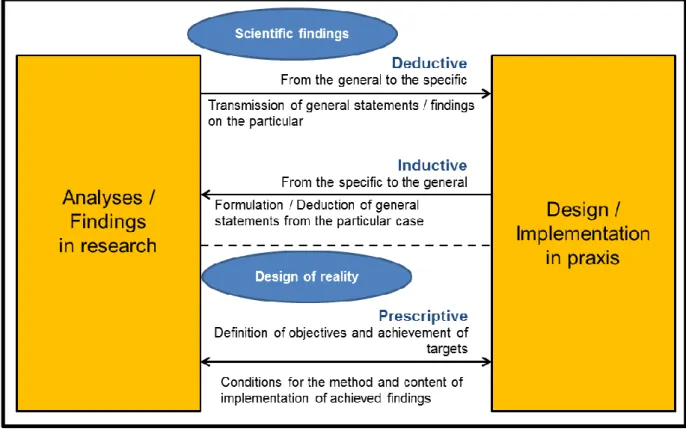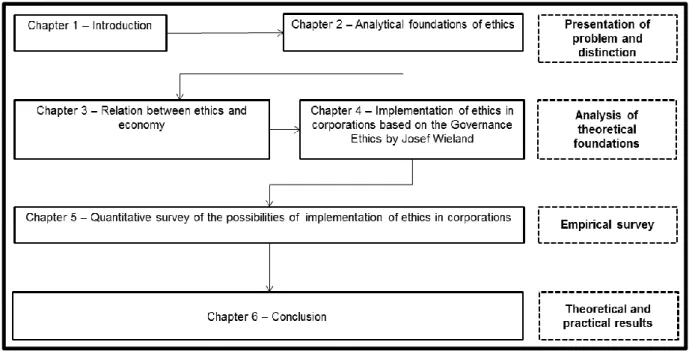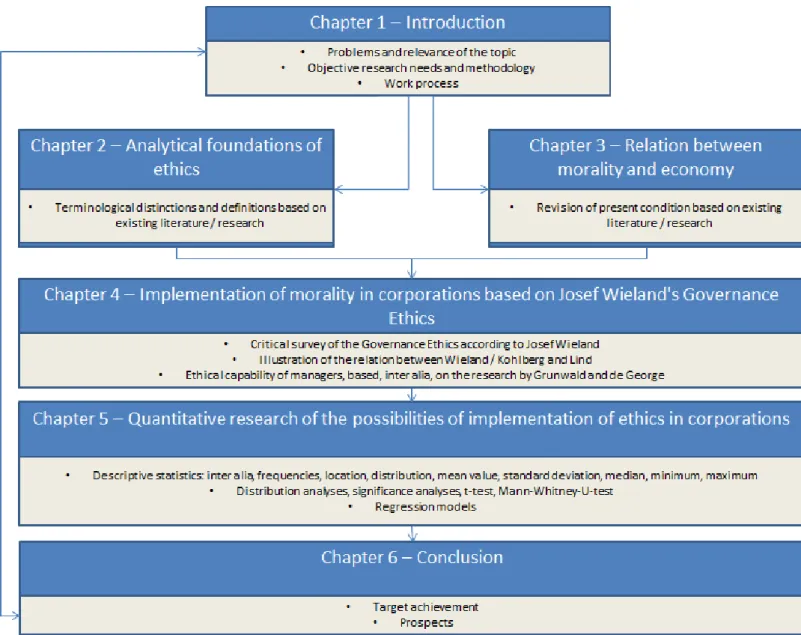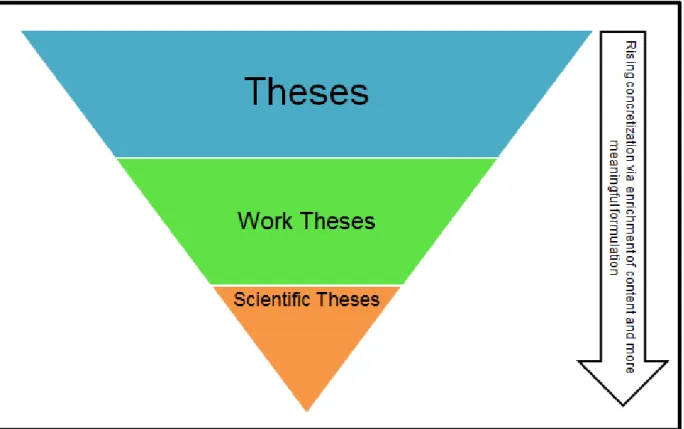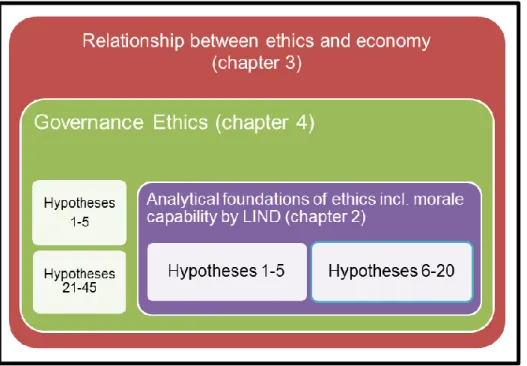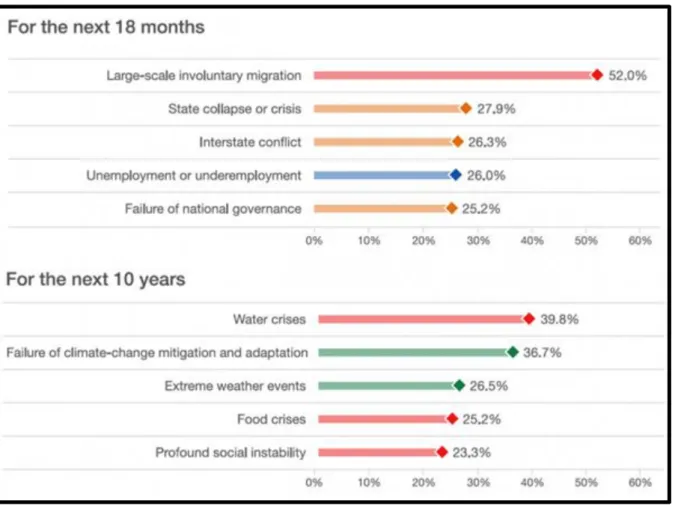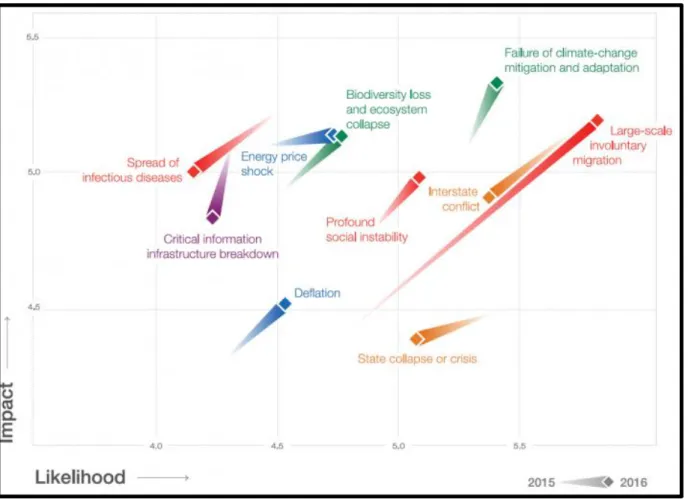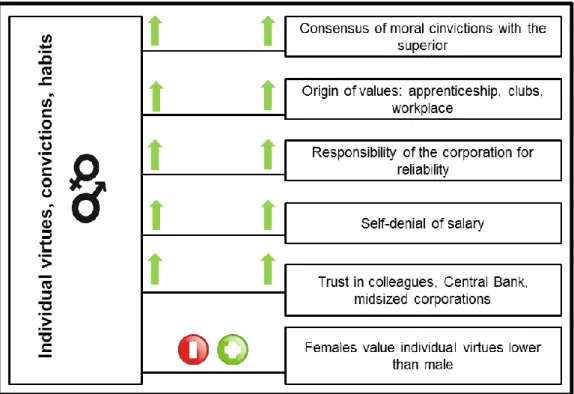Corporate Ethics
-The Nexus between Quantitative Analysis of the Coefficients of Governance Ethics and Moral Competence-
Thesis booklet
University of West Hungary - Sopron Alexandre Lamfalussy Faculty of Economics
by
from Germany
approved by
Uni.-Prof. Dr. Irena Zavrl PhD
Sopron 2016
Table of Content
Table of Content
List of Figures ... II
1. Introduction ... 1
1.1 Problems and relevance of the topic ... 1
1.2 Objectives, Research Needs and Methodology ... 2
1.3 Process of the work ... 4
2. Quantitative study on the possibilities of implementation of ethics in the corporations ... 6
2.1 Methodische Vorbedingungen und Restriktionen ... 6
2.2 Study design ... 8
2.3 Research Design ... 10
2.4 Forming hypotheses ... 12
2.5 Organizational Design – Conclusions and recommendations ... 15
3. Conclusion ... 17
3.1 Target achievement ... 17
3.2 Prospect ... 17
Appendix ... 21
Bibliography ... 24
List of Figures
List of Figures
Figure 1: Movement of the cognitive process ... 4
Figure 2: Process of work ... 6
Figure 3: Study design ... 9
Figure 4: Research Design ... 11
Figure 5: The process of forming hypotheses ... 13
Figure 6: Linking scientific theories and hypotheses ... 14
Figure 7: The biggest global risks ... 19
Figure 8: Development of global risks – 2015/2016 ... 20
Figure 9: Results regarding the C-Score ... 21
Figure 10: Results regarding individual virtues, convictions, habits ... 21
Figure 11: Results regarding internal instruction of the corporation ... 22
Figure 12: Results regarding the influence of laws ... 22
Figure 13: Results regarding the influence of culture, religion and ethics ... 23
1. Introduction
1. Introduction
1.1 Problems and relevance of the topic
„ It is the responsibility of all citizens to lead ethical discourse in public. “1
The financial crisis of recent years has clarified the distortions within the economic system.
However, since this crisis is not only based on faulty or insufficient regulations, but also on willful misconduct of existent – partly lawful – rules, a certain corporate culture is necessary in order to guarantee that one pays attention to certain frameworks.2 The result is an analytical focus on the binding values that support the functionality of our companies and the economy as a whole.3 These values include: sustainability, human dignity, trust and reliability, which sometimes can be realized only by a value binding process. 4 Furthermore, the corporations are burdened with significantly higher levels of ethical economies than in the past, according to current understanding.5 According to Emunds and SCHERER, this is based on the fact that companies move their business activities to countries that impose lower moral standards.6 By the dependence of the states on the value-adding companies and the financial market, the cor- porations and participants are able to develop pressure to further reduce the existing legal reg- ulations.7 Therefore it is increasingly important that both the company and the manager / staff are made aware of the increasing importance of an ethical commitment that goes far beyond mere compliance with laws,8 as we are expected to move towards more anonymous social sys- tems.9 According to REHM it seems reasonable that it depends mainly on the individual be- havior of economic agents, next to statutory provisions and standards.10 The clear allocation of responsibility regarding economic actions is thus of importance.11 Hence, the need for an ex- panded basic research in business ethics arises that reveals how moral values emerge in sus- tainable businesses and are effectively implemented, respectively.12 Here, the implementation is of utmost importance for the modern philosophical ethics.13 The company is in this thesis to
1 Homann, K. (2007a), Page 57.
2 Cp. Hollstein, B. (2010), Page 123.
3 Cp. Hollstein, B. (2010), Page 123.
4 Cp. Hollstein, B. (2010), Page 123.
5 Cp. Crouch, C. (2013), Page 233-234; Emunds, B. (2010), Page 98.
6 Cp. Emunds, B. (2010), Page 99; Scherer, A. G. (2003), Page 428-433 quoted by Emunds, B. (2010), Page 98- 99.
7 Cp. Bourdieu, P. (2004), Page 59-60, 122; Crouch, C. (2013), Page 111; Emunds, B. (2010), Page 99.
8 Cp. Crouch, C. (2013), Page 233-234; Emunds, B. (2010), Page 99.
9 Cp. Hirsch, F. (1980), Page 170; Homann, K., Suchanek, A. (2000), Page 54.
10 Cp. Rehm, H. (2012), Page 477.
11 Cp. Rudolph, B. (2010), Page 449.
12 Cp. Hollstein, B. (2010), Page 123.
13 Cp. Homann, K. (2001b), Page 86.
1. Introduction
be perceived as an experience space and in the further course illustrates the object of experi- ence14.15
1.2 Objectives, Research Needs and Methodology
This thesis positions itself/starts precisely on this object of experience as the objective and fo- cuses on the governance ethics by WIELAND. This is supplemented with the quantitative ap- proach to the moral judgment test by LIND. This is done by following the objective to exam- ine the coefficients of governance ethics in connection with the basic moral capability. There- by, in terms of the knowledge object16, the central research question is to be answered: What impact do the components of the function according to Wieland (Tmi = f (aISi, bFIij, cIFij, dOKKi) have on economic transactions in the corporations? Out of the information gained in cause-effect relationships, laws can then optionally be made for implementing morality in the business processes.
In this context, WIELAND has already worked out in 2005 the corresponding gap in research, or the need for research, namely that coefficients of governance ethics are not estimated val- ues, which allow a significance statement.17 However, he admits the eventuality that govern- ance ethics may be able to help us perform statistical estimates on the effect of the coeffi- cients.18 This assumption is the basis for research of the dissertation.
Following WIELAND the self-conception of this thesis is characterized by the economic and business ethics discourse being a 'work in progress' derived from different scientific disci- plines.19 This assumption postulates that neither neoclassicism, nor the associated standard theories, as also the philosophy, were previously able to generate application-oriented eco- nomic and corporate ethics, which are both consistent and empirically meaningful.20
In order to, at least partly, claim consistency to this knowledge, the Chapters Two to Five fol- low different consecutive goals: 21
• Descriptive objectives: Chapters 2, 3, 4
• Theoretical objectives: Chapters 4 + 5
• Pragmatic objectives: Chapters 5 + 6
Analogous to the consecutive objectives, five research questions can be divided into the fol- lowing categories: 22
14 Object of experience = Erfahrungsobjekt = „Menschliches Handeln und Verhalten als Gegenstandbereich mit wissenschaftlich interessierenden Phänomenen“ Töpfer, A. (2012), Page 47.
15 Cp. Hollstein, B. (2010), Page 123.
16 Knowledge object = Erkenntnisobjekt = „Entdecken von Regelmäßigkeiten als Ursachen-Wirkungs- Beziehungen möglichst in Form von Gesetzmäßigkeiten bezogen auf Verhalten, Entscheiden und Han- deln…“ Töpfer, A. (2012), Page 47.
17 Cp. Wieland, J. (2005a), Page 31, Fußnote 24.
18 Cp. Wieland, J. (2005a), Page 31, Fußnote 24.
19 Cp. Wieland, J. (2005b), Page 1; Wieland, J. (2006), Page 6.
20 Cp. Wieland, J. (2004a), Page 5; Wieland, J. (2005b), Page 1.
21 Cp. Chmielewicz, K. (1994), Page 8ff; Schweitzer, M. (1978), Page 2ff. both quoted by Töpfer, A. (2012), Pa- ge 52.
1. Introduction
• Descriptive research questions – Chapters 2,3,4 1. What relevant terms characterize the corporate ethics?
2. What is the relationship between morality and economy?
• Theoretical research questions – Chapters 4 + 5
3. How are ethics compatible in companies on the basis of governance ethics by WIE- LAND?
4. What influence do the components of the function have (Tmi = f (aISi, bFIij, cIFij, dOKKi) on economic transactions in the corporations according to Wieland?
• Praxeological research questions – Chapters 5 + 6
5. What recommendations can be given on the basis of the findings?
For the purposes of an accepted scientific culture of debate, the dissertation develops a dialec- tical approach, where plausible cause-effect mechanisms and a contrary declaration option to the examined effect phenomena are juxtaposed.23 This approach follows the critical rational- ism and the deductive hypothetical deployment and documentation of theories, which allow for the thesis and antithesis to develop a cognitive progress, which is both intersubjectively understandable and verifiable by predetermined criteria.24 Both the practical real relevance as well as the theoretical, methodological rigor and exactness are estimated as high-leveled with this approach, and therefore fulfill the conditions of the 'Pragmatic Science'25 according to Anderson and the 'Use-inspired Basic Research'26 according to Stokes. This alignment ensures strong theoretical foundation coupled with a pragmatic science.27 To arrive at a full realization process, following the deductive procedure there are deduced inductive derivatives of general- ly valid statements of the individual case and guidelines for implementing the findings.
22 Columns are based on TÖPFER. Cp. Töpfer, A. (2012), Page 156.
23 Cp. Töpfer, A. (2012), Page 27.
24 Cp. Töpfer, A. (2012), Page 27.
25 Cp. Anderson, N., Herriot, P., Hodgkinson, G.P. (2001), Page 394 quoted by Töpfer, A. (2012), Page 57.
26 Cp. Stokes, D.E. (1997), Page 73 quoted by Töpfer, A. (2012), Page 61.
27 Cp. Töpfer, A. (2012), Page 57.
1. Introduction
Figure 1: Movement of the cognitive process28
1.3 Process of the work
In line with hermeneutics, this dissertation has also developed over the processing time.29 The initial idea has changed, has been reflected and is no longer the same as the start of pro- cessing.30 Following HOFSTADTER, examples are selectively accessed to facilitate compre- hension and to allow analogies to the experience of the reader.31
In the first chapter the problem and the need for research, the objectives and methodology as well as the course of work, are documented. In Chapter Two the analytical foundations of eth- ics are presented. The emphasis is on the identification and demarcation of the terms. Because only with the determination of terms can right thinking and judgments succeed, especially when these concepts make judgments.32 The claim here is to determine terms as clear and un- ambiguous as possible, to avoid possible confusion and to achieve the necessary selectivity.33 Only with the help of these concepts can the world be perceived from a certain perspective.34
28 According to: Töpfer, A. (2012), Page 67.
29 Cp. Joas, H. (2013), Page 252.
30 Cp. Joas, H. (2013), Page 252.
31 Cp. Hofstadter, D. (2014), Page 126.
32 Cp. Zsifkovits, V. (2005), Page 13.
33 Cp. Zsifkovits, V. (2005), Page 13.
34 Cp. Neuhäuser, C. (2011), Page 23.
1. Introduction
The definitions follow certain mandatory criteria. This means that the definitions must be log- ically coherent.35 They may not contradict present scientific empirical experience and they must be geared to the everyday intuitions and customs.36
In Chapter Three, the analysis of the relationship between morality and economy is per- formed. By means of this chapter, the logical foundations and the necessity to implement the morality in corporative transactions are outlined. This multidimensional perspective is based on structured literature reviews with which the phenomena of the economy and the companies are analyzed.37
In Chapter Two and Chapter Three the conducted empirical studies (including LIND, KOHLENBERG etc.) are already incorporated. But a deepening of this approach is realized in particular in Chapter Four where the 'Implementation of morality in the company on the basis of Governance Ethics by Josef Wieland' is made the subject. Besides WIELAND's habilita- tion dissertation, much of his extensive publications are incorporated into this fourth chapter.
The Nexus of Chapter Two, Three and Four result in theoretical foundations and definitions being connected with the analysis of current economic phenomena and the differentiated analysis of existing scientific work. In Chapter Five the empirical quantitative analysis is per- formed. A total of 869 completed questionnaires were answered by the target group of part- time students in the Ruhr area, as defined by the Ruhr Regional Association, who study dual or part-time, in the period from August 2014 to February 2015. Of these 869 questionnaires 769 were usable and were implemented into the empirical analysis.
In Chapter Five the methodological preconditions and restrictions as well as the investigation, research, testing and design style are explained in order based on the empirical analysis -in the sense of TÖPFER conclusions and draw lines of design recommendations for business prac- tice to be able to make.38 The concluding Chapter Six then treated the achievement of objec- tives and the prospects for the purposes of further possible research fields and topics.
In summary, the 'Process of Work' can be shown aggregated in the following figure.
35 Cp. Neuhäuser, C. (2011), Page 23.
36 Cp. Neuhäuser, C. (2011), Page 23.
37 Cp. Töpfer, A. (2012), Page 29.
38 Cp. Töpfer, A. (2012), Page 41.
2. Quantitative study on the possibilities of implementation of ethics in the corporations
Figure 2: Process of work39
It corresponds to the sequence of the structure of scientific knowledge process in which ini- tially the definitions, classifications and descriptions are followed by the theoretical empirical analysis and finally design recommendations.40
2. Quantitative study on the possibilities of implementation of ethics in the corporations
2.1 Methodische Vorbedingungen und Restriktionen
It has to be stated that science, and thus, the present research, may not congruently reflect re- ality.41 Rather, science uses a particular perspective, as part of its efforts, and thereby utilizes very specific questions/and issues/problems as well as abstractions.42 Consequently contradic- tory results of different sciences not necessarily contradict each other, but are based on possi- bly, minimally different questions.43
Explanations and arguments, in the context of ethics, are regularly closely related to the ap- propriate target audience that is being investigated.44 This leads to very different results, in- cluding those affected by "age, education level, group affiliation, cultural background, ..." 45.46
39 According to: Töpfer, A. (2012), Page 41.
40 Cp. Töpfer, A. (2012), Page 41.
41 Cp. Homann, K. (2014), Page 38.
42 Cp. Homann, K. (2014), Page 38.
43 Cp. Homann, K. (2014), Page 39.
44 Cp. Homann, K. (2014), Page 40.
45 Homann, K. (2014), Page 40.
46 Cp. Homann, K. (2014), Page 40.
2. Quantitative study on the possibilities of implementation of ethics in the corporations
Moral judgments may in turn be caused by different "historical, social and economic condi- tions of the system…"47 and coexist without contradiction, despite their discrepancies.48 These designated restrictions have to be considered, when assessing the following tests, and should not be excluded.
In its basic structure, the investigation follows TÖPFER and his remarks.49 It should be further mentioned that the economic faculty in Sopron limits the total number of pages of the disser- tations. This limitation means that all research results could not be documented in the text, but submitted in the appendix or in digital form. Among other things, the 'Moral Judgement Test' by LIND was used.50 This test offers many advantages (high validity and reliability)51, howev- er, based on a very rigid frame,52 which was immutably adopted for the present dissertation.
47 Homann, K. (2014), Page 41.
48 Cp. Homann, K. (2014), Page 41.
49 Cp. Töpfer, A. (2012), entire work.
50 Cp. http://www.uni-konstanz.de/ag-moral/, Update: 29.07.2015.
51 Cp. http://www.uni-konstanz.de/ag-moral/mut/mjt-engl.htm#valid, Update: 16.05.2016.
52 Cp. http://www.uni-konstanz.de/ag-moral/mut/mjt-engl.htm#dear, Update: 29.07.2015.
2. Quantitative study on the possibilities of implementation of ethics in the corporations
2.2 Study design
The present work subsequently uses a dialectical approach, with the objective to enable sub- stantial scientific discourse, in order to achieve the greatest possible progress of knowledge.53 It was also, in the previous chapters, in addition to the structured analysis of the literature, ex- tensively drawn on existing research results to detect firstly, the current state of research, and to avoid redundancies with other already completed research activities. This Chapter 5 deals with the primary research, which develops possible cause and effect relationships in the form of a quantitative research.
Opting for a quantitative research has been made for various reasons. Thus, with a quantita- tive research, reality may be objectified and new findings from already known topics (here Corporate Ethics) can be found.54 Quantitative research is deductive, as is oriented theory test- ing, and allows a standardized approach under precise reduction of social interaction.55 The focus on statistical and mathematical methods allows a high level of measurement and the use of correspondingly larger samples with the aim of ordinary statistical representability.56 This should ultimately lead to the fact that a generalization of statistical findings on the basis of population is made possible.57 In order to claim a study design, in the sense of “a visualized outline of the different chapters in their sequence, concurrency and networking”58, the follow- ing figure, as an introduction to the quantitative research, again illustrates the overall context graphically.
53 Cp. Töpfer, A. (2012), Page 27.
54 Cp. http://www.empirical-methods.hslu.ch/empirical-methods/h-forschungsprozess/h-uebersicht- forschungsprozess.htm, Update: 08.02.2016.
55 Cp. http://www.empirical-methods.hslu.ch/empirical-methods/h-forschungsprozess/h-uebersicht- forschungsprozess.htm, Update: 08.02.2016.
56 Cp. http://www.empirical-methods.hslu.ch/empirical-methods/h-forschungsprozess/h-uebersicht- forschungsprozess.htm, Update: 08.02.2016.
57 Cp. http://www.empirical-methods.hslu.ch/empirical-methods/h-forschungsprozess/h-uebersicht- forschungsprozess.htm, Update: 08.02.2016.
58 Töpfer, A. (2012), Page 29.
2. Quantitative study on the possibilities of implementation of ethics in the corporations
Figure 3: Study design
2. Quantitative study on the possibilities of implementation of ethics in the corporations
2.3 Research Design
Based on Chapter 1.2 of this thesis [booklet] three basic theses have been derived in the framework of the dissertation. By means of TÖPFER these theses do not have listed exhaust- ively mature thoughts on possible cause-effect relationships:59
1. A high moral ability has a positive impact on the connectivity of morality in business.
2. Certain values are associated with a high moral ability and the functional components of governance ethics.
3. The functional components of governance ethics have a positive impact on economic transactions within the company.
The ensuing research design puts the research questions three and four in the strategic focus.
The first two questions have been answered in detail in the appropriate chapters.
59 Cp. Töpfer, A. (2012), Page 179.
2. Quantitative study on the possibilities of implementation of ethics in the corporations
Origin of values Influence level
Strategy level
Design level
Impact level
research question 3+4
Salary cut for realizing ethical convictions
Trusting third parties Compliance with other
ethical convictions
Meaning of ethical values compared to corporate revenues
Gender Age Income C-Score
Hierarchy of values Responsibility of
corporations
Options of actions for corporations
Corporations
Figure 4: Research Design60
60 Own figure.
2. Quantitative study on the possibilities of implementation of ethics in the corporations
On the influence level in research design are the main influencing factors. These include the origin of the values, gender, age based on the birth years, income and in particular the so- called C-score from the moral judgment test (MUT) after LIND to allow the connection to the moral capacity of players.61 The impact level shows the consequences due to the empirical re- sults of the Wielandic function. Here the connection between the research questions three and four and the following working hypotheses is examined:
1. The values of the coefficient of Governance Ethics are influenced by the moral capaci- ty of individuals.
2. The coefficients of the Governance Ethics show similarities with certain moral convic- tions.
3. The coefficient of Governance Ethics correlate with specific areas of responsibility, for which corporations have to take responsibility.
4. The coefficients of Governance Ethics correlate with a certain hierarchy of values.
5. The coefficients of Governance Ethics correlate with the confidence to third person groups.
6. There is a willingness to give up salary to implement one's personal moral convictions in the corporation.
7. Moral values are more important than corporate profits.
These working hypotheses are subsequently converted into scientific hypotheses and recom- mendations for companies and employees are derived, depending on the research results.
2.4 Forming hypotheses
Based on the central research question (See Chapter 1), the theses (See Section 2.3) and work- ing hypotheses (See Section 2.3), the scientific hypotheses and null hypotheses (See Appen- dix 1 of the dissertation) were conducted. The fact that the scientific hypotheses were con- ducted at the beginning of their own research activities, is based on the previously discussed
61 C-Score = “The main score, the C-index, of the MCT measures the degree to which a subject's judgments about pro and con arguments are determined by moral points of view rather than by non-moral considera- tions like opinion-agreement. It indicates, to use Piaget's terminology, the degree to which moral principles have become „necessary knowledge" (Lourenço & Machado, 1996, p. 154) for the respondent.”
http://www.uni-konstanz.de/ag-moral/mut/mjt-intro.htm#moral_comptence, Update: 29.07.2015; “Only a very few respondents get a maximum score of one hundred; even most university graduates get a score be- low 45.” http://www.uni-konstanz.de/ag-moral/mut/mjt-engl.htm#measure, Update: 29.07.2015.
2. Quantitative study on the possibilities of implementation of ethics in the corporations
approach of Critical Rationalism and includes the requirement that hypotheses can always fail in reality.62
Figure 5: The process of forming hypotheses 63
This was followed by the creation of the questionnaire. For ease of understanding and because of the many scientific hypotheses, a connection of the scientific hypotheses with the respec- tive questions was made directly. For reasons of space, these scientific hypotheses and null hypotheses are contained in Appendix 1 of the dissertation. Appendix 1 includes the deriva- tion and the basis of the respective hypotheses.
In this connection, reference is made at this Popper's point to the view: “How a scientist comes to a hypothesis is, according to Popper, neither capable nor in need of a logical recon- struction. Not capable because hypotheses are often won by pure intuition without this proce- dure being according to any (apparent) rules. Not in need because it is logically irrelevant as to how a researcher comes to his hypothesis, logically important for knowledge is solely its review.”64 SEDLACEK agrees with this statement in relation to the assumptions and the men- tal orientation of models and postulated that the selection is performed completely irrational- ly.65 He recommends in this context: “Therefore, economists need to approach reality with humility.”66 Furthermore, the hypotheses are, especially in the field of the economic and so- cial sciences, space-time-dependent, non-time-stable and they are working with 'quasi-
62 Cp. Kromrey, H. (2006), Page 54.
63 According to: Töpfer, A. (2012), Page 179-180.
64 Schurz, G. (2013), Page 27-28.
65 Cp. Sedlacek, T. (2012), Page 373.
66 Sedlacek, T. (2012), Page 374.
2. Quantitative study on the possibilities of implementation of ethics in the corporations
nomological hypotheses or limited time-stabil-hypotheses'.67 Despite this freedom in the for- mation of scientific hypotheses, the following figure will outline how the scientific hypothe- ses were derived based on the present theories, and in which areas of the questionnaires the theories or scientific hypotheses are found.
Figure 6: Linking scientific theories and hypotheses
As illustrated, all scientific hypotheses derive from the theories by WIELAND and LIND, fo- cusing on the Governance Ethics by WIELAND. Hypotheses 1-5 provide an interface be- tween WIELAND and LIND. In all hypotheses the findings from Chapter 3 flow implicitly in order to take into account the perspective of the corporations and the economy.
67 Cp. Prim, R., Tilmann,H. (2000), Page 89ff. quoted by Töpfer, A. (2012), Page 83.
2.5 Organizational Design – Conclusions and recommendations
Based on the descriptive statistics and the inclusion of the significant hypotheses, it shall now be focused on answering the research questions in the context of primary research. These were:
1. How are ethics in companies on the basis of WIELAND's Governance Ethics capable?
2. What influence do the components of the function according to Wieland
(Tmi = f (aISi, bFIij, cIFij, dOKKi) have on economic transactions in the corporations?
Taking into account the results of the descriptive research, then these can support the following statements:
i. Individual virtues, beliefs and habits have the greatest effect on typical economic transac- tions within the corporation.
ii. Parents have the greatest influence on the origin of the values of their children.
iii. 71.8% of the respondents are showing a willingness to renounce salary for the implemen- tation of their personal moral convictions.
iv. The own moral convictions agree most consistently with those of the parents.
v. Work colleagues are the most trusted among respondents.
vi. The most important value is honesty.
vii. The guarantee of human rights is the most important responsibility that should be adopted by corporations.
viii. The C-score decreases with age.
ix. Women have a slightly lower C-score than men.
These results clearly demonstrate the possibilities of connectivity of ethics in the corporation.
Corporations should put a strong emphasis on individual virtues, beliefs and habits (point i). The often present assumption that morality is based solely on the compliance with applicable laws,68 was able to be refuted.
Equating ethics and compliance is therefore wrong. The ethical-psychological experiments by HARTSHORNE and MAY (1928) were able to be refuted.69 The focus of HOMANN on the pre- vailing legal order framework is rejected by the respondents.
Here, the company should consider the situation of parents (point ii and iv). Parents have the strongest influence on the values and moral convictions of their children.
Consequently, the personal and economic situation of parents is also a factor that should be accen- tuated in selection processes. Useful values of the parents will be transferred in a positive sense to the children and vice versa.
68 Cp. Lind, G. (2015), Page 35.
69 Cp. Lind, G. (2015), Page 35.
2. Quantitative study on the possibilities of implementation of ethics in the corporations
Since 71.8% of the respondents accept a salary cut if the company follows the moral beliefs of the employee, it is evident that right at the beginning of the employment relationship, a congruence between the moral value of the employee and the corporation needs attention. As fellow workers are attributed the greatest confidence in the corporation, a more careful selection process of all generations of employees introduces a perpetuation of the values in the corporation.
The most important value mentioned by the respondents was honesty. Thus, corporations should demand honesty and promote, on the contrary, consistently punish dishonesty. Corporations should not violate human rights. As a helpful orientation the corporation can look at the Universal Declaration of Human Rights and the Universal Declaration of Human Rights in Resolution 217 A (III) from 10.12.1948.70 From the falling C-score with age (viii) no direct knowledge is derived, as the majority of those questioned are between the ages of 20 and 30. Nevertheless, this approach could be a starting point for further research and be further investigated. The same applies to the knowledge of descriptive statistics, that women have a lower C-score than did men (point xi).
For better understanding, the results with respect to the C-score and the functional components of Governance Ethics are compressed in graphs (See Appendix of the thesis booklet), to once again make a contribution to a better overall comprehension.
To implement the recommendations presented and to take account of the results collected, the corporations should implement a value management to improve the connectivity of ethics. With such value management, the corporation can also give the function of components of Governance Ethics enough attention to check whether the assessment of the employees, the impact the compo- nents of the function have, according to Wieland (Tmi = f (aISi, bFIij, cIFij, dOKKi), on econom- ic transactions in the corporations, and to what extent these are congruent with the management or the owner. Such value management would give the necessary orientation to employees and man- agers as well as customers, business partners and investors.71 However, please note that the mere documentation of value management is insufficient. Rather, it is necessary that the statements and instructions documented here cover the lived business practice.72 DORMANN has already pointed out that the role of the executives and especially the management is of utmost importance.73 This coincides, as already explained, with the results of the present work. “Lack of leadership in value management involves unpredictable risks and can have far-reaching negative consequences.”74 Possible consequences would be loss of image and long term, decreasing economic success of the company.75 Conversely, a successful value management results in a “... strong corporate identity, motivation and self-responsibility, according to flexible and efficient processes, more customer and employee satisfaction, social acceptance and ultimately growing business potential.”76
Specifically, the results of this thesis were to play a role both in the standards of conduct, as well as in the selection and promotion of staff.77 Because only then the organization can be ascribed a
70 Cp. http://www.ohchr.org/EN/UDHR/Pages/Language.aspx?LangID=ger, Update: 19.06.2016.
71 Cp. Dormann, J. (2004), Page 7.
72 Cp. Dormann, J. (2004), Page 7.
73 Cp. Dormann, J. (2004), Page 7.
74 Dormann, J. (2004), Page 9.
75 Cp. Dormann, J. (2004), Page 9.
76 Dormann, J. (2004), Page 9-10.
77 WIELAND supports this: Cp. Wieland, J. (2004b), Page 24.
3. Conclusion
sustainable self-description by self-attachment to values.78 Since both the connectivity of ethics as well as the effectiveness of functional components of the Governance Ethics by WIELAND could be proved in the context of the studies, the author puts himself in line with the following statement by WIELAND: “The comprehensive perspective of value management means that there may not be any behavioral and procedural principles in a company or in one of the applications that are not part of this [value management].”79
3. Conclusion
3.1 Target achievement
In reference to the introduction and the specific objectives, it can be stated that the coefficients of Governance Ethics could be investigated in conjunction with the fundamental moral capacity.
The defined research questions 1-5 (See Chapter 1 of the thesis booklet) could be answered. The theoretical and conceptual foundations were discussed in Chapter Two in detail. The essential terms were differentiated and a uniform conceptual scope of comprehension was defined. Fur- thermore, the moral faculties were represented by LIND in Chapter Two. In the subsequent Chap- ter Three the relationship between ethics and economy was described in detail. It should be stated that a consistent conception of the relationship between ethics and business does not exist or can be formed, respectively. There are in many examples – as shown in Chapter Three – too many di- vergent interests of the different economic agents involved. This led to the question of how ethics can be efficiently connected with business? This question was thoroughly answered with a de- tailed discussion of the Governance Ethics by WIELAND. Then, in Chapter Five, a quantitative study in which over 800 people were interviewed was conducted. After adjusting the question- naires 769 usable questionnaires remained. Using the knowledge from the quantitative research, cause-effect relationships and laws for the implementation of morality could be obtained in the business processes. The research gap, already perceived in the 2005 by WIELAND, that he (WIELAND) does not exclude that the coefficients of Governance Ethics represent estimated val- ues that allow a significance statement,80 could be proved in the present research.
In Chapter 5.5 recommendations for business practice were deduced from the knowledge ob- tained.
3.2 Prospect
Specifically, the two theoretical research questions:
How are ethics compatible in companies on the basis of governance ethics by WIELAND
What influence do the components of the function have (Tmi = f (aISi, bFIij, cIFij, dOKKi) on economic transactions in the corporations according to Wieland?
78 Cp. Wieland, J. (2004b), Page 23.
79 Wieland, J. (2004b), Page 35.
80 Cp. Wieland, J. (2005a), Page 31, footnote 24.
3. Conclusion
will accompany the research as part of corporate ethics in the coming years and decades. In view of the current megatrends:81
1. Knowledge Culture 2. Urbanization 3. Connectivity 4. Neo-Ecology 5. Globalization
6. Individualization / Customization 7. Health
8. New York 9. Gender Shift 10. Silver Society 11. Mobility 12. Safety
society will change to a considerable extent, which will continue to cause the set of values not be- ing static, but being marked by changes to a considerable extent.82 How ethics remain capable of upholding a connection in business in the course of these changes in the coming decades, is one of the crucial questions within corporate ethics and the functional components by WIELAND can certainly contribute to this issue in the future. Facing the risks of the present world, World Eco- nomic Forum in Davos shows that especially risks within and between countries are of considera- ble importance in addition to the migration. The so-called 'Brexit' of Britain from the European Union is just one example.83
81 Cp. https://www.zukunftsinstitut.de/dossier/megatrends/, Update: 25.06.2016.
82 Vgl Dormann, J. (2004), Page 9.
83 Cp. http://www.faz.net/aktuell/politik/brexit/, Update: 25.06.2016.
3. Conclusion
Figure 7: The biggest global risks84
This development will, inter alia, lead to the increased dependence of the states from the value- adding corporations, and hence the importance of the corporation in the sense of moral responsi- bility for the society. In comparing the years 2015 to 2016, it is also worth mentioning that the global risks (See Figure 8) have increased and many of these risks are within the responsibility, or within the sphere of influence, of corporations, and bring obvious moral issues with them. As an outstanding example, for the purpose of risk probability, climate change is mentioned, which is mainly caused by the corporations.
84 Taken from: http://reports.weforum.org/global-risks-2016/shareable-infographics/, Update: 25.06.2016.
3. Conclusion
Figure 8: Development of global risks – 2015/201685
As a result, the study of corporate ethics will have to deal with the treated research questions of this thesis in the coming years.
85 Taken from: http://reports.weforum.org/global-risks-2016/shareable-infographics/, Update: 25.06.2016.
Appendix
Appendix
Figure 9: Results regarding the C-Score
Figure 10: Results regarding individual virtues, convictions, habits
Appendix
Figure 11: Results regarding internal instruction of the corporation
Figure 12: Results regarding the influence of laws
Appendix
Figure 13: Results regarding the influence of culture, religion and ethics
Bibliography
Bibliography
This booklet uses literature which is a part of the bibliography of the dissertation itself. The author refers to this bibliography within the dissertation because due to the formal rules and regulations this booklet should only the publications by the author. The following chronological descending numeration does not contain any editorship´s.
Müller, N., Jäger, C. (2015), WERTEorientierte Führung von Familienunternehmen, Wiesbaden, 2015
Florenz, A., Jäger, C. (2015), Total Beta vs. wahrer Unternehmenswert - Eine kritische Diskussi- on zum Thema Total Beta und Empfehlungen für die Bewertungspraxis, in: WP Praxis Nr. 12 vom 25.11.2015, Page 309
Bauchrowitz, L., Jäger, C., Sain, S. (2014), Empirical analysis of the Degree of Diversification and Its Impact on Business Performance and Corporate Valuation by Shareholder, Aachen, 2014
Jäger, C., Frère, E., Knoche, J. (2014), Behavioral economic approaches towards irrationality and manipulation with a basic application to a neoclassical economic model, Aachen, 2014
Jäger, C., Sain, S., Kuhlmann, D. (2014), Emotional and Experiential Effects on Customer Brand Loyalty - A View from the German Food Sector, Aachen, 2014
Bensch, T., Jäger, C., Jäger, T., Holsiepe, H. (2013), Alternative Approaches of Corporate Valua- tion Methods for Small and Medium Sized Enterprises, in: Journal of Economy & Society, No.
2013, Sopron, 2013
Bensch, T., Jäger, C., Jäger, T., Janßen, M. (2013), CSR-Reporting Under Special Consideration of Drivers and Quality Criteria, in: Journal of Economy & Society, No. 2013, Sopron, 2013
Jäger, C., Lombeck, V. (Hrsg.), (2013), Corporate Valuation of Web 2.0 Companies, in: Siemens- FOM-Wissenschaftskooperation, Aachen, 2013
Jäger, C. / Simsek, K., (2013), Analyse der Kultur als Determinante des Neuromarketings, Aachen, 2013
Bibliography
Frère E., Jäger, C., Nadilo, C. (2012), Investor Relations in börsennotierten Unternehmen – Empi- rische Untersuchung im Rahmen des Kapitelmarktes, Aachen, 2012
Jäger, C., Soylu, A. (2012), Emotionale Intelligenz – Kritische Evaluierung und praktische Um- setzungsanalyse im Rahmen der unternehmensgebundenen Personalführung, Aachen, 2012
Bensch, T., Jäger, C., Jäger, T. (2012) World Events Impact The German Stock Market: DAX Analysis January 2000 to October 2009, in: Journal of Economy & Society, No. 2012, Sopron, 2012
Jäger, C. (2012), Private Limited Company – theoretische, rechtliche und praxisorientierte Analy- se, in: Frère, E.: Beiträge zum Corporate Finance- und Wertpapiermanagement, Essen, 2012
Jäger, C., Jäger, T., Hofmann, D., Bensch, T. (2011) Scientific evaluation of Sound Branding as an integrative part of brand management, in: Journal of Economy & Society, No. 2011 / 3-4, Sopron, 2011
Jäger, C., Messing, A. (2011), The Sound of Branding – Sound Branding im Rahmen der Marken- führung, in: Schriften zur angewandten Mittelstandsforschung (SMf), Schauf, M., Schmittmann, J, (Hrsg.), München, 2011
Jäger, C., Maciejewski, K. (2011), Early Warning Indicators – The Importance of Performance Measurement und Special Consideration of Financial Crisies, Aachen, 2011
Jäger, C., Böckhaus, C. (2011), The Black & Scholes formula and resulting advancements – Deri- vation and interpretation with special focus on the validity of the underlying assumptions, Aa- chen, 2011
Jäger, C., Altrogge, C., (2011), Beyond Budgeting vs. Better Budgeting – Wohin geht die Zu- kunft, in: Schriften zur angewandten Mittelstandsforschung (SMf), Schauf, M., Schmittmann, J, (Hrsg.), München, 2011
Bensch, T., Jäger, C., Jäger, T. (2011), World Events Impact the German Stock Market: DAX Analysis January 2000 to October 2009, in: Journal of Economy & Society, No. 2011, Sopron, 2011
Jäger, C. (2009), Customer Relationship Management, in: Der Businessplan in der Medizinwirt- schaft, Startbahn MedEcon Ruhr (Hrsg.), Bottrop, 2009
Bibliography
Jäger, C. (2009), Wissenschaftliche Einführung, in: Der Business Plan als Managementaufgabe, Frère E., (Hrsg.), Essen, 2009
Jäger, C., Höller, V. (2009), Game Theory and its application to strategic management, Norder- stedt, 2009
Jäger, C., Ciesla, K. (2008), Deflation –Theory and Consequences for Private and Company Be- haviour, Norderstedt, 2008
Jäger, C., Maciejewski, K. (2008), Project Management: An Elaboration on the Effectiveness of Leadership, Norderstedt, 2008
Jäger, C., Wolke, C. (2008), Make-or-Buy Decisions -A Transaction Cost Theoretical Approach to the Assessment of Outsourcing Activities-, Norderstedt, 2008
Jäger, C., Gerhard, A. (2008), Deflation -theoretische Ansätze und managementorientierte Umset- zungsanalyse-, Norderstedt, 2008
Jäger, C. (2007), Management Basics, Essen, 2007
Frère, E., Jäger C. (2005), Private Limited Company –theoretische, rechtliche und praxisorientier- te Analyse, Essen, 2005
